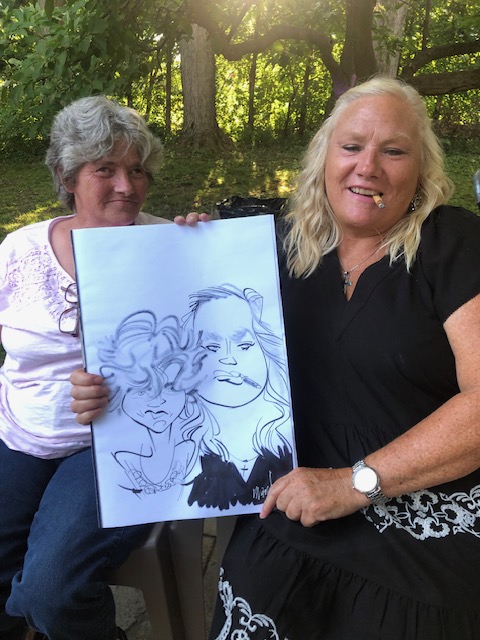
What Picasso might have created if he’d learned how to draw. I have to admit I may have made Rosinantes too small. I’ll fix that when I paint him.
We did it! We slogged through every first piece of vernacular Western literature (written in the author’s own language rather than Latin)—at least all the ones I can think of. German, English, Italian, French, Spanish. Chivalry and knights in shining armor sure was a popular subject. It’s as if: even as writers were moving everyone into a more modern age they needed to fondly look back and say so-long to the Middle Ages.
Spanish author Miguel Cervantes (mee-GEL sair-VAHN-tez) was having none of that. It was the late 1500s, the Middle Ages were over and their foolishnesses needed to be lampooned. In his book, El Ingenioso Hidalgo Don Quixote de la Mancha (The Ingenious Gentleman Don Quixote of La Mancha), the doddering old gentleman Don Quixote (DON kee-HO-tay) is obsessed day and night with reading those poems of chivalry and knights and their mighty deeds—to the point where his brain dries out. It’s cooked. Don Quixote loses his marbles; he becomes demented. Don Quixote gets the idea he should put on an old suit of armor he finds in a barn and become a knight-errant to restore honor to Spain. He talks a local peasant, Sancho Panza, into being his squire by promising him a parcel of real estate. The Don chooses as his steed a moth-eaten, played-out scrawny old horse named Rosinantes. As a nod to courtly love, he fixates on a local girl he calls Dulcinea—but she has no idea that she’s being honored this way.
Don Quixote and Sancho go adventuring across the countryside, questing for wrongs to be righted and monsters to vanquish. In the book’s most famous scene, Don Quixote (whose eyesight isn’t so good) mistakes a windmill for an ogre and charges at it with his lance. He gets caught up in the windmill’s vanes and has to be untangled. In nearly every other adventure, Don Quixote and Sancho get beat up by whomever they encounter.
Don Quixote is considered to be the first modern novel (a book-length work of fiction). Cervantes intended to move us out of the past into modernity, and he sure did. One bit of pure writing genius: Don Quixote speaks Old Spanish while the other characters speak modern Spanish. For us English speakers, imagine a modern novel’s character speaking like Chaucer or Shakespeare. Cervantes’ readers understood Don Quixote’s dialogue but he sounds antique and out-of-step.*
* In fact, Aldous Huxley used this gag in Brave New World to give us information about a character—https://www.litcharts.com/lit/brave-new-world/chapter-7
Wikipedia has a comprehensive entry for Don Quixote, including a summary of the story:
https://en.wikipedia.org/wiki/Don_Quixote
Look! You can get a poster of the title page of the 1605 edition of Don Quixote: https://www.amazon.com/Quixote-Ntitle-Cervantes-Published-Valencia/dp/B07C4K5LDY/ref=asc_df_B07C4K5LDY/?tag=hyprod-20&linkCode=df0&hvadid=527702999903&hvpos=&hvnetw=g&hvrand=9503647619533183764&hvpone=&hvptwo=&hvqmt=&hvdev=c&hvdvcmdl=&hvlocint=&hvlocphy=9005111&hvtargid=pla-1401775165677&psc=1
https://www.biography.com/writer/miguel-de-cervantes
And here’s Peter O’Toole in the musical Man of La Mancha. In this scene, Cervantes is in prison, entertaining his fellow prisoners. In real life he’d been imprisoned twice, the first stretch for 5 years as a guest of the Turks. https://www.youtube.com/watch?v=iH9nDlBr3b4
You can visit Don Quixote’s windmills—https://www.awayn.com/listing/all_listings/consuegra-spain-consuegra-the-windmills-of-don-quixote-hiking-trip/
Hey, whadayaknow—Sophia Loren’s in this movie, too! She’s Dulcinea, who maybe wasn’t so unaware of being treated like a lady. I know, it’s hokey, but I’m a sucker for this kind of stuff—https://www.youtube.com/watch?v=42y15BYusmA&t=209s
Back to the beginning of The Western Civ User’s Guide to Reading & Writing.
Don’t forget: I wrote another Western Civ User’s Guide! Back to the beginning of The Western Civ User’s Guide to Time & Space.







































